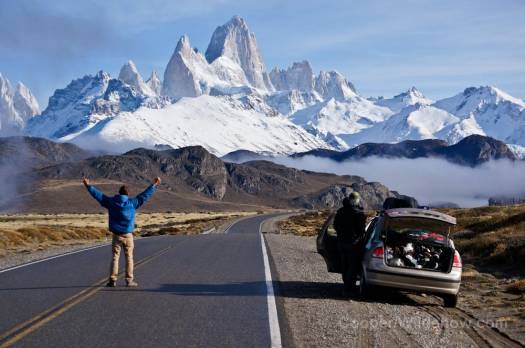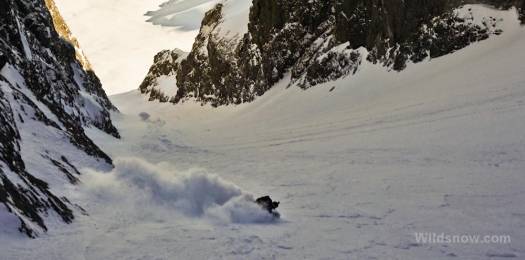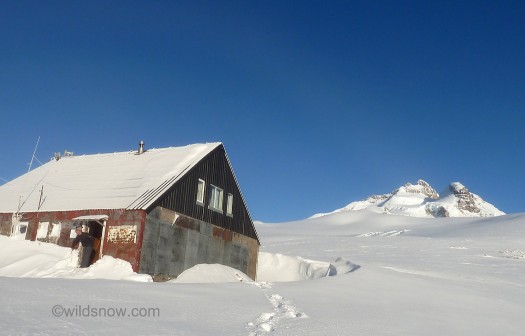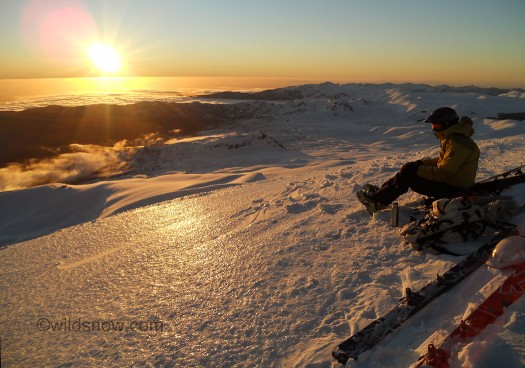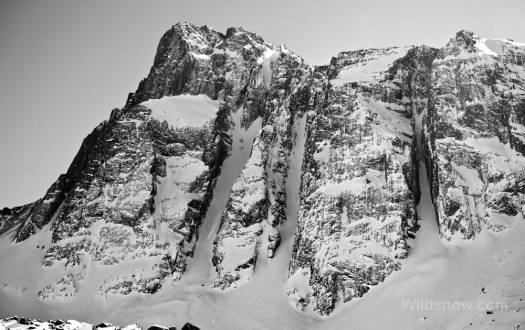(It’s getting a bit late for a Southern Hemisphere ski trip. However, I’ve skied powder down there in mid September, and depending on conditions and region their spring ski season can last a while. I figured I’d share a bit of knowledge from two extensive trips, for those interested in following the southern winter. We’ll make this post somewhat “evergreen” so it’ll be useful for future seasons as well. This post sponsored by our publishing partner Cripple Creek Backcountry.)
This post is sponsored by our publishing partner Cripple Creek Backcountry, check out their shopping options.)
The most important advice I have for a South America ski trip: be flexible and enjoy the adventure of it. Snow conditions greatly vary throughout the massive continent. On both my trips I did not commit to any certain area ahead of time, and just went where it looked like there was good skiing when I arrived. On my second trip we flew into Santiago. The skiing near there was literally nonexistent. We bused 18 hours south to Bariloche and found a thin snowpack (and rain). Then we drove three days south, to El Chalten, and finally found superb conditions. Friends who stayed around Santiago didn’t get any skiing until several weeks later.
Budget: I’m a dirtbag at heart, and I’ve found that with a little work, a South American ski trip can be incredibly affordable. I kept total costs well under $1500 for a 6 week trip (not including airfare). If you’re not as much of a scrimper, you can still do it fairly cheaply while also having a cush experience. Lodging (hostels), bus travel, and food are inexpensive. Items that are oriented towards gringo tourists, such as rental cars, ski passes, and ski area slopeside lodging, tend to be comparatively expensive. Luckily, as backcountry skiers, we don’t need to mess with ski resort nonsense. If you do go to a ski area, expect to pay normal U.S. lift ticket prices for an often sub-par experience. The advantage of going to the resorts is that travel may be quite a bit easier; you can usually book it all, get picked up in Santiago, and just ski (assuming conditions are ok and you can afford it all).
On both trips I tried to go to areas that were less popular and a bit more adventurous. I’ve never been to Portillo, Las Lenas or Valle Nevado, which are probably the most popular South American ski areas. Interestingly, every time I’ve traveled the conditions at those areas were not great.
Guidebook: During one trip, a dude we met had this guidebook. It’s expensive to buy online, but has some good info. Probably not worth $70 though. Keep an eye out when you’re down there for it, you might be able to pick up a cheap copy from another traveler, or at least have a look. Some ski shops have a copy, as well. My local shop, ProSki, in North Bend, has a copy that you can take a look at. Also, it’s written by a French guy, and I’ve heard it is much cheaper to buy it in bookstores in Europe.
Language barrier: I can speak a bit of Spanish, and can often understand the gist of a conversation in Central American Spanish. When it comes to Chilean and Argentinean Spanish I can hardly understand a thing. Both trips I have done with my good friend Skyler, who speaks much better Spanish than me and can communicate pretty effectively — even with mumbling Chileans. Not many locals speak English, especially in rural areas, so knowing some Spanish is super helpful. It’s certainly not necessary, however.
Transportation: During my first trip, we got around entirely by hitchhiking, bus and taxi. Compared to the U.S., the hitchhiking is incredibly easy. The bus system is also incredible. It’s reliable, really cheap, and there’s a bus that goes to every tiny little town. Unlike U.S. long distance buses, the majority of the population regularly uses buses, so there aren’t many weirdos, and it feels fairly safe. The buses are run by a bunch of private companies that have little booths in the big bus stations. It can be hard to figure out which bus to buy tickets for, and where to buy them if your Spanish isn’t good. Only a few of the big bus companies have websites, and they don’t seem to work very well. You can find much better deals, and have many more options for times and destinations, if you shop around inside the bus station. Also, if you want to go somewhere along a bus route where they don’t normally stop, such as a base of a remote volcano, just ask. The bus drivers are often fine with dropping people off at unscheduled locations along the route, and sometimes you can even get them to pick you up in a few days at the same spot.
Taxis are very cheap and I don’t recall encountering any more sketchiness than I’ve seen elsewhere (e.g., the proverbial “I don’t have change for that” scam). We often would get a taxi from the bus station, and simply ask the driver to take us to a hostel, they always seemed fairly honest. There is also a system of “collectivo” taxis in bigger cities, which is basically a low-tech uberpool type service, which is even cheaper than the normal taxis. Even though the transport in Chile and Argentina is relatively safe, it’s still necessary to practice basic street smarts, especially in the bigger cities. Be watchful for any scammy behavior, or anything else that seems sketchy. Don’t overpay for anything, be wary of anyone approaching you attempting to sell something, and don’t let anyone “guard” your luggage or carry your luggage, etc.
On my second trip we went a few places via bus, and also rented a car for two separate portions of the trip. Both times we rented a car we got a ripped off, so be careful. Car rental prices are a bit cheaper than the states, but still fairly comparable. Scams include things like mechanical systems that don’t work, such as 4-wheel-drive, and worn out tires you don’t notice because you’re distracted by the sales lot situation. One service also tried to charge us for a bunch of toll roads that I’m sure we didn’t drive on. Thus, while renting, take your time and think through what you need to inspect to make sure you’re getting what you pay for. Also, always use a credit card so you can dispute the charge if you do get taken.
Lodging: Hostels are generally the way to go if you want it to be cheap. There’s lots of hostels, all are geared toward the busy summer season so they’re generally completely empty in the winter. We rarely had to share the bunk room with anyone else, so it’s basically a cheap private room. It’s hard to find most hostels online, especially the ones in small villages. We would generally ask a local such as a taxi driver or bus company employees. In the more popular ski destinations, you’ll probably find some fellow skiers staying at the hostel. We also did quite a bit of camping to save money. In smaller towns, we would simply ask around if there was anyone who would be fine with us camping in their yard; we often found a spot for little or no money. We met some really interesting locals this way.
Places to ski: Now, about where to go skiing! I hesitated to share some of this info, but ultimately decided to do it for a few reasons. For one, most of these areas are difficult to get to, involving either lots of travel, or a long approach, or both. I’m still leaving lots of adventure in store to anyone who wants it. Also, ski mountaineering is not exactly a popular sport in South America, especially in any of the areas I’m talking about (with the possible exception of Refugio Frey). Most of these areas can handle some more traffic, and I’d love to hear about more people exploring these areas on skis. The only area on this list that is in danger of being over crowded is Refugio Frey, and that place isn’t exactly a secret, so here it goes.
I’ve skied 11 volcanoes in South America. Most are fairly easy to find and figure out how to ski. Here’s my favorites:
Lanin: My favorite volcano descent in South America. The peak, at over 12,000 feet, is one of the highest volcanoes in Patagonia. We took two days to climb it, and stayed in a sturdy little concrete hut about halfway up. We skied a nice steep run on the Northeast face. Trip report here
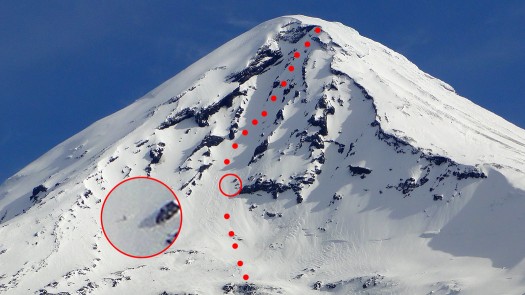
Our descent line on the North East side of Lanin. One of the coolest lines I’ve skied in South America. The dot in the red circle is me skiing, to give you a sense of scale.
Tronador: Another cool volcano, reminiscent of of PNW volcanoes with complex glaciated terrain. There is a nice hut that has an area that is open for winter use. We didn’t find the best skiing, but that was mostly because of the conditions. I think in good conditions it could be a fun descent. Tronador means “thunder” in Spanish, and the mountain has a giant icefall feature below one of the glaciers that you hike past on the ascent. Ice falling off the cliff created an almost continuous series of thunderous roars for several hours as we hiked past. Really impressive. Trip report here.
Puyehue: Many will recognize this as the crater that they skied into in the “All I Can” ski movie. The volcano ascent is quite mellow, and the crater holds some fun, steep, (and short) lines. The approach hike is fairly long, and some opt to hire some horses to carry their gear. We stayed in a run-down cabin at the base. This volcano is very active, and recent eruptions may have affected the approach or the skiing. There is also a nearby lava flow that was created only a few years before we skied there. We did a little side trip, and it was a really unique experience to clamber around on steaming lava that had only cooled a few milliseconds ago, in geologic time. Trip report for Puyehue and Osorno here.
Villarica: Most of the volcanoes we skied were quite short, mellow, and had little to no approach. Villarica was one of them. Simply start skinning at the ski area parking lot at the base. The coolest element of Villarica is that the open crater holds bubbling lava. Unfortunately during winter the hot lava creates billowing steam that is difficult to see through. If the conditions are just right, however, you might see some lava.
Chillan: The three Chillan volcanos are a fairly popular ski destination. The ski area is large, by Chilean standards, and it has a substantial base village and hotel. There are incredible hot springs here, both a commercial one, that I haven’t tried, and a natural river of hot water, which is absolutely one of the 7 wonders of ski mountaineering. There is cheap lodging in the nearby town of Las Trancas, and also a run-down refugio on the lower slopes of the mountain, which can be a fun place to camp. We spent quite a few days here, and Lou 2 went there during his trip as well, a few years ago. Trip reports here and here and here.
In addition to the volcanoes, here are a few of the best places we skied (in very roughly north to south order).
Cajon de Maipo: The furthest north area I’ve skied in South America. It’s a deep valley a few hours outside of Santiago. It is probably the best skiing I’ve had down there. Massive peaks, good access, good snow, and fairly unknown. The access is provided by a road for some sort of hydro project goes way into the alpine. The project is ongoing, so the access situation is ever-changing. There is a hostel/cheap hotel in the nearby village. It would be difficult to hitchhike or take a bus here, you most likely need a car, and probably one with some good clearance (and perhaps 4 wheel drive, that works). Trip report here and here.
Refugio Frey: An incredible hut, in a cirque of incredible rock spires and couloirs. The nearest town is Bariloche, a cool town, although a bit ritzy and touristy (it’s the “Aspen” of south america). You can still find cheap lodging and food (and it’s a bit more sketchy) on the outskirts. There is also very active alpine club in Bariloche, with a full-time staffed office downtown that has great info and is a great way to meet people. Refugio Frey is right behind the ski area of Cerro Catedral. A bit of a burly hike in from the ski area base (lots of dirt unless it’s a really good season), although you can also go from the top of the lifts and its easier. If you pay, you can get dinner, lunch, and breakfast here, as well as beer. You can also bring your own food and cook outside. lodging is cheap, dinner and stuff not so much (although still cheap compared to any other hut, probably about $15 for dinner or so). This is the most “crowded” backcountry ski spot I’ve been down there (basically the only place I’ve been where we saw other backcountry skiers. Trip report here from my first trip down there, and here and here are TR from my last trip, when the conditions weren’t as good. There are a few other refugios in the area, and there is the potential to do a cool traverse between them which we attempted in that last TR. I think to do the full traverse conditions would have to be very good; lots of alpine travel in big avalanche terrain.

A sampling of the Couliois we skied above Refugio Frey. All in all, we skied 17 chutes, a few more than once, mostly in powder. Couloir overload!
Chalten area: We did a looong road trip down to “real” Patagonia, and skied around Fitz Roy and the Torres Del Paine Area. Wild place down there, and some really cool skiing. It’s certainly a well known area for summer adventures, but I haven’t heard of many people skiing down there. Chalten has some of the most beautiful mountains in the world, and we managed to find some brilliant skiing there. Chalten is a bustling place in the summer, but it is very quiet in the winter, and many places are closed. There also aren’t many buses that travel there in the winter months. We rented a car, and drove down, which proved to be an adventure. Ruta 40 travels through sparsely populated country, and the road isn’t well maintained, to say the least. Bring a spare gas can. Trip report here and here and here.
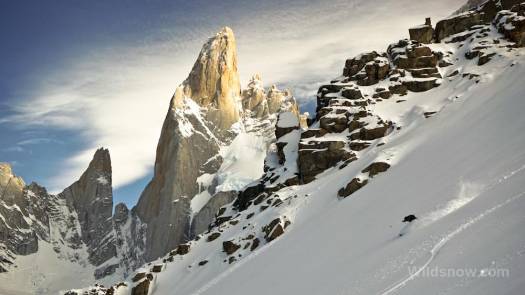
Skiing below the spires of Fitz Roy. The most scenic run of my life? Probably. Worth the 3 day road trip through the desert? Definitely.
Tores Del Paine: Even further south. Although glaciated, the areas around the famous spires didn’t have much snow when we were there. We still found some fun skiing, although it required a long day of dirt-walking to get to. The refugios, shops, and other national park infrastructure that is active in the summer is completely closed, so come prepared. Here’s a trip report from skiing in Torres Del Paine
There you go, head south!
Louie Dawson earned his Bachelor Degree in Industrial Design from Western Washington University in 2014. When he’s not skiing Mount Baker or somewhere equally as snowy, he’s thinking about new products to make ski mountaineering more fun and safe.

